Lock Blog
A resource for consumers, locksmiths, and security professionals
A resource for consumers, locksmiths, and security professionals
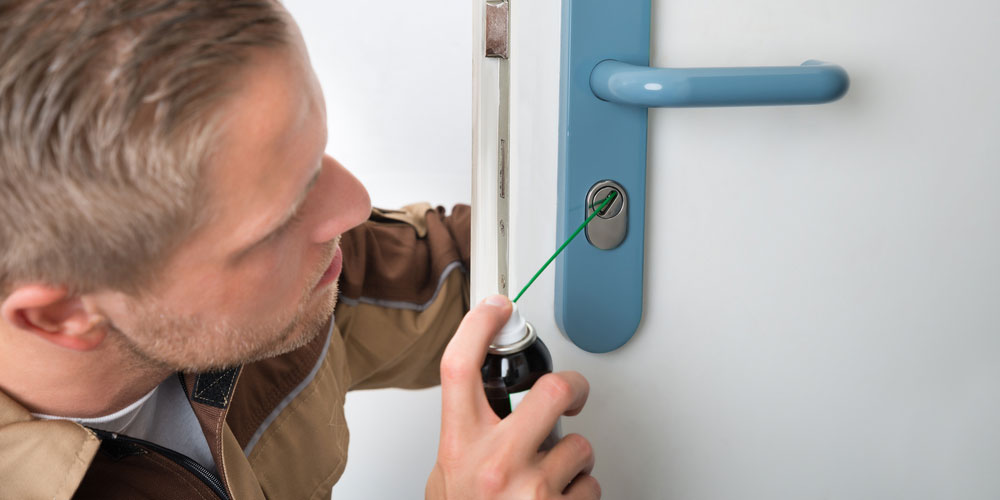
The subject of door lock lubricant is a touchy one for the lock and security community. Everyone has their favorite product and bad experiences with a certain lube. But in this article, I will do my best to cut through all the biases and give you the smoothest path to the truth.
What you need to know about door lock lubricant comes down to:
When it comes to regularly scheduled lock maintenance, “regular” is a bit of a misnomer. Instead, think of lubricating your locks as soon as an issue is detected. You do not want to wait until the lock is not functional to use your door lock lubricant.
Door lock lubricant is needed when debris accumulates in the keyway or crevices of a lock, decreasing the ease of use. In some cases, a lock that needs lubrication may stop working altogether, mimicking the behavior of a fully broken lock.
To know if door lock lubricant will solve your lock issue, lubricate it. As long as you are using the best door lock lubricant, it will not harm your lock to troubleshoot your problem in this way. Lubrication is the fastest and cheapest fix for a malfunctioning lock, so give it a try.
Special consideration for lubricating outdoor locks is using a product that protects against rust. One of the main reasons an outdoor padlock won’t open is due to an accumulation of rust. To remove rust in the keyway, lubricant will be needed. But it would be better if the lube stopped the rust from coming back.
Hardware stores, hobby shops, and online retailers carry many door lock lubricants or lubricants that can be used on door locks. Lubricants are multi-purpose, so be sure the product you purchase fits the parameters of one of the best door lock lubricants.
There are many instances where door lock lubricant is all you need to get your lock back to functioning properly. Most commonly, people want to know how to lubricate a door lock when their key is not inserted easily, or something is sticking.
If applying door lock lubricant does not get your lock working again, the lock has too severe of damage or blockage. It may be possible to continue troubleshooting your issue, but if you cannot get to the route of what is going on, contact a local locksmith.
As long as you use a door lock lubricant that meets these parameters, you will be using a quality door lock lubricant.
Dry – A dry lube refers to the fact that it is not oil-based. Look for products that express that it is a “dry lube.” Spray-based lubricants can be dry. Do not let the fact the spray is liquid in texture fool you, as this will dry, leaving no oily residue.
No Residue – When you touch certain graphite lubricants and oil-based lubricants, you can see and feel a lingering residue. In the case of oil-based lubricants, they can collect debris. In humid climates, the fine graphite residue can sometimes clump and bind the lock.
No Stains – Graphite and oil can leave stains. Because oil-based lubes do not dry quickly, there is a greater risk of staining residue transferring from surface to surface. And even though graphite I dry, the fine dust can still stain clothing, carpets, doors, etc., just as a pencil would.
In the locksmith industry, people care a lot about their door lock lubricant. So this will most likely be a more controversial list than intended. If you disagree with this list or want to make the case for Tri-Flow, please let me know in the comments below.
It is also important to remember that door lock lubricant might not be the solution to your problem. Locks can suffer damage that requires deeper cleaning than a lube can provide. Though lubrication is a method for how to clean door locks, it does not fix all issues.
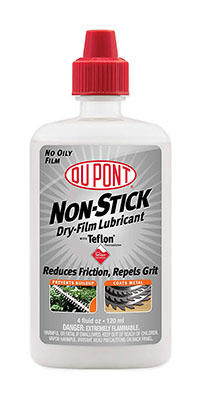
I did not set out thinking that one of the best door lock lubricants would be in a squeeze bottle, but the formula for the DuPont Teflon Non-Stick Dry-Film Lubricant was very impressive. The documented testing shows the least amount of residual residue I have ever seen.
Using an alcohol liquid base speeds up the time it takes for the lubricant to dry, which limits the potential time it would have to stain anything. Overall, it is a very impressive dry lubricant and does not contain silicone.
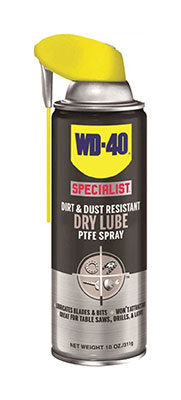
When it comes to door lock lubricant, most professionals turn up their noses at the WD-40 brand. However, the WD-40 Dry Lube PTFE Spray proves that you should not throw the dry lube out with the oil-based lubricant. Though standard WD-40 is not recommended, this version is.
Under documented testing, the PTFE spray outperformed standard locksmith-recommended door lock lubricant Tri-Flow. The lock cylinder and pin chambers remained cleaner, and the spray made more significant improvements to the lock’s functioning overall.
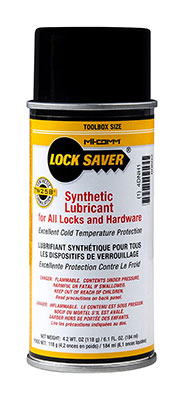
I have to put Lock Saver lubricant on this list because it is such a reliable product. The reviews on its product page demonstrate that it is not just my experience either. On side-by-side comparisons with standard WD-40, the Lock Saver is shown to leave no oily staining substance.
This product boasts its cold temperature protection, which many lubricants do not. If you are looking for the best lubricant for outdoor locks in colder climates, this product would be at the top of my list.
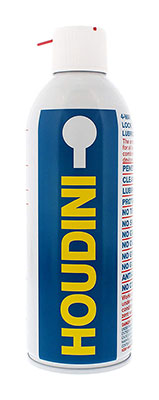
With a name like Houdini, you expect a bit of magic, and I have not met many who are disappointed in that regard. Houdini Lock Lube is a dry synthetic spray that does not use graphite, silicon, Teflon, or oil. No lingering residue to gum up the lock and no staining.
It is also a contender for the best lubricant for outdoor locks because of its anti-rust and anti-corrosion protection. All around, this door lock lubricant should give you everything you need to get a sticky lock working again.
If it works as a lubricant, you can use it as a door lock lubricant, right? Yes and no. For example, the extremely common WD-40 oil-based lubricant can get your lock back in working order. But there is the major drawback of the oil collecting more residue over time.
When spraying an oil-based lubricant on a lock, you will be able to get successful temporary results. However, the oil draws in dirt and dust, creating a dark gooey substance that gums up the internals of the mechanism.
After using an oil-based lubricant, it may be as soon as a couple of weeks before you experience the same or more severe issues with your lock. When you go to clear out your lock with the correct door lock lubricant, you will likely be removing a black, sticky, viscous substance, which is caused by the oil residue.
Key Takeaways:
We have often espoused the virtues of graphite door lock lubricant but have always tried to remind readers of the potential mess it can leave behind. The messiness of misapplied or over-applied graphite can result in stains, which may be difficult to remove from doors or fabric.
Graphite is a more old-school door lock lubricant, and that means it can be a bit finicky to use. Overspray can cause drips, and the leaking substance is not dabbed or wiped away, it can fall onto carpets, clothing, the door, etc.
If you spray the graphite lubricant in the keyway, the substance can also spread to the key. Graphite can stain hands, pockets, tables, or whatever the keys touch. The problem with graphite door lock lubricant is not that it has to be messy, but that it has the risk of messiness.
Key Takeaways:
When your key is not inserting smoothly, needs to be jiggled to get the lock to work, or the key gets stuck in the lock, often, all you need to do is learn how to lubricate a door lock in the following way:
The method above can also be used if you need to know how to lubricate a car ignition cylinder if your car key won’t turn in the ignition or you have a key stuck in the car ignition. This is also a potential car door lock fix.
If your key won’t turn or the door lock is stuck in lock position, try the following:
A combination wheel that sticks or jumps makes imputing the combination very difficult. This can be especially bad when you are changing the combination on a safe, as you could end up setting a sequence of numbers you did not intend or record.
So try to use this method of how to lubricate a combination safe lock:
When a safe won’t open, it could be because of jammed bolts or a sticking handle. You can also lubricate these parts of a safe, even if it is not a combination safe. Though to best lubricate the bolt assembly on a safe, it must be opened.
Before you look into how to remove a broken padlock, make sure you know how to lubricant a padlock properly. Sometimes this is all that is needed to clear away rust that is jamming the lock. For keyway issues or combination padlocks, refer to the sections above.
Throughout the history of padlocks, lubrication and cleaning have been very important because of how exposed these locks are to the elements. In terms of how to lubricate a padlock specifically, here is what you need to know:
Most of the best padlocks can be taken apart for a more extensive cleaning, but this is only possible if the lock can be opened.
Once you know how to lubricate a lock and the best door lock lubricant to use, this still might not solve your issue. After applying the lube, your lock may continue to malfunction due to damage or the need for more extensive cleaning or repairs.
Sometimes it takes more than knowing how to lubricate a lock. And in those instances, it is a good idea to consult with a professional locksmith. See if there is a United Locksmith in your neighborhood. If you have any thoughts or questions, please leave them in the comments below.
Category: Buying Guides, How To's, Residential